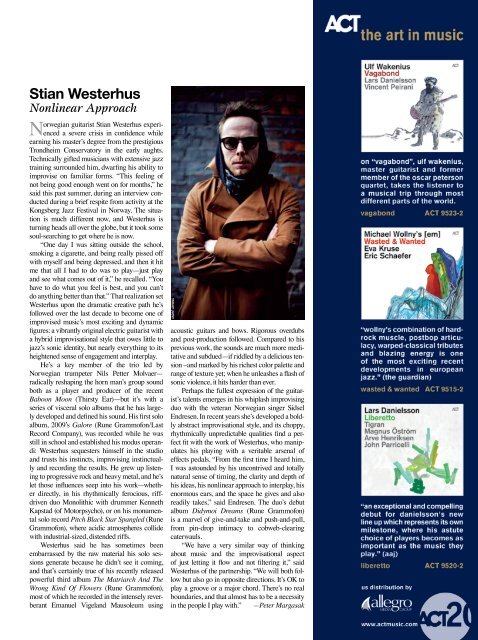Ron Carter Esperanza Spalding - Downbeat
Ron Carter Esperanza Spalding - Downbeat
Ron Carter Esperanza Spalding - Downbeat
You also want an ePaper? Increase the reach of your titles
YUMPU automatically turns print PDFs into web optimized ePapers that Google loves.
Stian Westerhus<br />
Nonlinear Approach<br />
Norwegian guitarist Stian Westerhus experienced<br />
a severe crisis in confidence while<br />
earning his master’s degree from the prestigious<br />
Trondheim Conservatory in the early aughts.<br />
Technically gifted musicians with extensive jazz<br />
training surrounded him, dwarfing his ability to<br />
improvise on familiar forms. “This feeling of<br />
not being good enough went on for months,” he<br />
said this past summer, during an interview conducted<br />
during a brief respite from activity at the<br />
Kongsberg Jazz Festival in Norway. The situation<br />
is much different now, and Westerhus is<br />
turning heads all over the globe, but it took some<br />
soul-searching to get where he is now.<br />
“One day I was sitting outside the school,<br />
smoking a cigarette, and being really pissed off<br />
with myself and being depressed, and then it hit<br />
me that all I had to do was to play—just play<br />
and see what comes out of it,” he recalled. “You<br />
have to do what you feel is best, and you can’t<br />
do anything better than that.” That realization set<br />
Westerhus upon the dramatic creative path he’s<br />
followed over the last decade to become one of<br />
improvised music’s most exciting and dynamic<br />
figures: a vibrantly original electric guitarist with<br />
a hybrid improvisational style that owes little to<br />
jazz’s sonic identity, but nearly everything to its<br />
heightened sense of engagement and interplay.<br />
He’s a key member of the trio led by<br />
Norwegian trumpeter Nils Petter Molvaer—<br />
radically reshaping the horn man’s group sound<br />
both as a player and producer of the recent<br />
Baboon Moon (Thirsty Ear)—but it’s with a<br />
series of visceral solo albums that he has largely<br />
developed and defined his sound. His first solo<br />
album, 2009’s Galore (Rune Grammofon/Last<br />
Record Company), was recorded while he was<br />
still in school and established his modus operandi:<br />
Westerhus sequesters himself in the studio<br />
and trusts his instincts, improvising instinctually<br />
and recording the results. He grew up listening<br />
to progressive rock and heavy metal, and he’s<br />
let those influences seep into his work—whether<br />
directly, in his rhythmically ferocious, riffdriven<br />
duo Monolithic with drummer Kenneth<br />
Kapstad (of Motorpsycho), or on his monumental<br />
solo record Pitch Black Star Spangled (Rune<br />
Grammofon), where acidic atmospheres collide<br />
with industrial-sized, distended riffs.<br />
Westerhus said he has sometimes been<br />
embarrassed by the raw material his solo sessions<br />
generate because he didn’t see it coming,<br />
and that’s certainly true of his recently released<br />
powerful third album The Matriarch And The<br />
Wrong Kind Of Flowers (Rune Grammofon),<br />
most of which he recorded in the intensely reverberant<br />
Emanuel Vigeland Mausoleum using<br />
andré løyning<br />
acoustic guitars and bows. Rigorous overdubs<br />
and post-production followed. Compared to his<br />
previous work, the sounds are much more meditative<br />
and subdued—if riddled by a delicious tension<br />
–and marked by his richest color palette and<br />
range of texture yet; when he unleashes a flash of<br />
sonic violence, it hits harder than ever.<br />
Perhaps the fullest expression of the guitarist’s<br />
talents emerges in his whiplash improvising<br />
duo with the veteran Norwegian singer Sidsel<br />
Endresen. In recent years she’s developed a boldly<br />
abstract improvisational style, and its choppy,<br />
rhythmically unpredictable qualities find a perfect<br />
fit with the work of Westerhus, who manipulates<br />
his playing with a veritable arsenal of<br />
effects pedals. “From the first time I heard him,<br />
I was astounded by his uncontrived and totally<br />
natural sense of timing, the clarity and depth of<br />
his ideas, his nonlinear approach to interplay, his<br />
enormous ears, and the space he gives and also<br />
readily takes,” said Endresen. The duo’s debut<br />
album Didymoi Dreams (Rune Grammofon)<br />
is a marvel of give-and-take and push-and-pull,<br />
from pin-drop intimacy to cobweb-clearing<br />
caterwauls.<br />
“We have a very similar way of thinking<br />
about music and the improvisational aspect<br />
of just letting it flow and not filtering it,” said<br />
Westerhus of the partnership. “We will both follow<br />
but also go in opposite directions. It’s OK to<br />
play a groove or a major chord. There’s no real<br />
boundaries, and that almost has to be a necessity<br />
in the people I play with.” —Peter Margasak
















